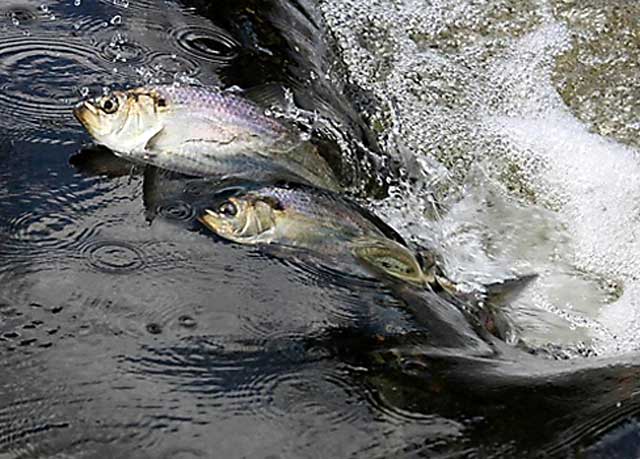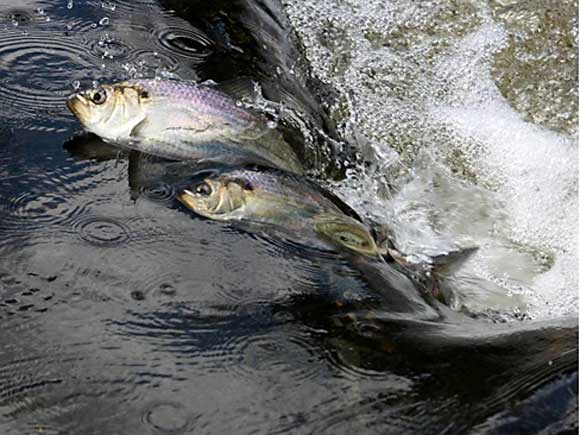DEEP extends ban on taking alewives, herring
The state Department of Energy and Environmental Protection (DEEP) announced Friday, April 5, that the prohibition on the taking of alewives and blueback herring from most inland and marine waters in Connecticut has been extended for another year.
This action was initially taken in April of 2002, and has been extended each successive year because there has been no improvement in population size during the past year. The current action by DEEP Commissioner Daniel C. Esty extends the prohibition through March 31, 2014.
“Despite the conservation efforts taken by this agency and others over the past decade, the runs of river herring in Connecticut are still diminished,” said DEEP Deputy Commissioner Susan Whalen. “The best available data from this past year indicates that the closure of these fisheries must therefore remain in place.”
River herring is a term used collectively to refer to alewife and blueback herring. Both species are anadromous, which means they hatch in freshwater, migrate to the ocean to grow, then return to freshwater to spawn. Historically, millions of river herring returned to Connecticut’s rivers and streams each year. More than 630,000 blueback herring were passed over the Holyoke Dam in Massachusetts on the Connecticut River in 1985. By 2006, only 21 passed the Holyoke Dam, the lowest number in the history of the Holyoke Fishlift. Last year that number was only 39. While river herring are not typically consumed by humans, they are important food to many species of freshwater and marine gamefish, as well as osprey, bald eagle, harbor seals, porpoise, egrets, kingfishers and river otter.
“We still are not certain about the exact cause of the decline in river herring runs, but there is no indication that there is a problem with Connecticut’s rivers and streams,” said William Hyatt, Chief of DEEP’s Bureau of Natural Resources “The decline has been observed all along the east coast and the common factor is the ocean and estuaries. There was a renewed effort during 2012 to address this problem and new steps have been taken. We now wait to see if they help.
“One of our top priorities is to protect populations of wild, native fish,” Hyatt said. “We must work with other states and organizations to protect river herring, which cross jurisdictional boundaries. The prohibition is expected to stay in place until monitoring by the DEEP indicates that the population has recovered to the point where it could safely support some level of harvest.”
During the past year, the New England Fisheries Management Council adopted new rules for commercial fishermen in the ocean to minimize river herring by-catch (unintended harvest) in the Atlantic herring fishery off the coast of northeastern states. A ruling by the National Marine Fisheries Service (NMFS) on whether or not to list both species of river herring under the federal Endangered Species Act was expected in 2012 but has now been delayed until 2013.
Non-migratory alewife populations are established in several lakes and ponds in Connecticut. The DEEP prohibition does not include landlocked alewives from Amos Lake, Ball Pond, Beach Pond, Candlewood Lake, Crystal Lake, Highland Lake, Lake Quassapaug, Lake Quonnipaug, Rogers Lake, Squantz Pond, Uncas Pond, and Lake Waramaug. Alewives in these lakes may still be taken by angling and scoop net as established in state statute and regulation.
The DEEP continues its other efforts to enhance river herring stocks by transplanting adult herring from streams with healthy runs into streams where runs have been eliminated or greatly depleted, removing obsolete dams and building fishways that allow fish to migrate past remaining dams. New fishways at the Hallville Dam on Poquetanuck Brook in Preston, the StanChem Dam on the Mattabesset River in Berlin, and the removal of the Rutan Dam on Anguilla Brook in Stonington as of April 1 will open more than 57 additional miles of habitat for river herring in the state.

